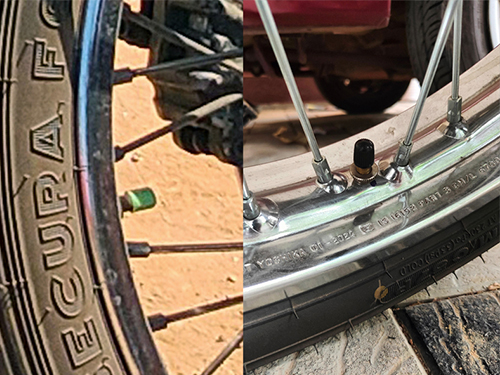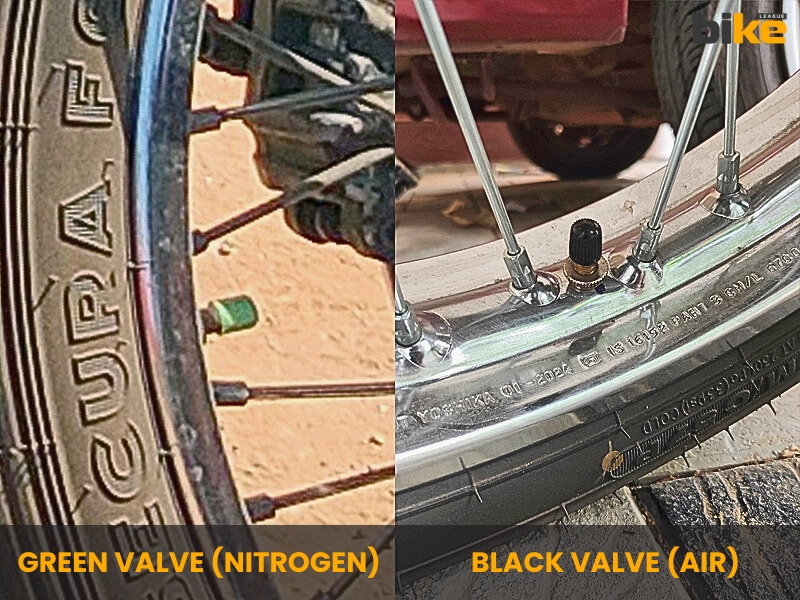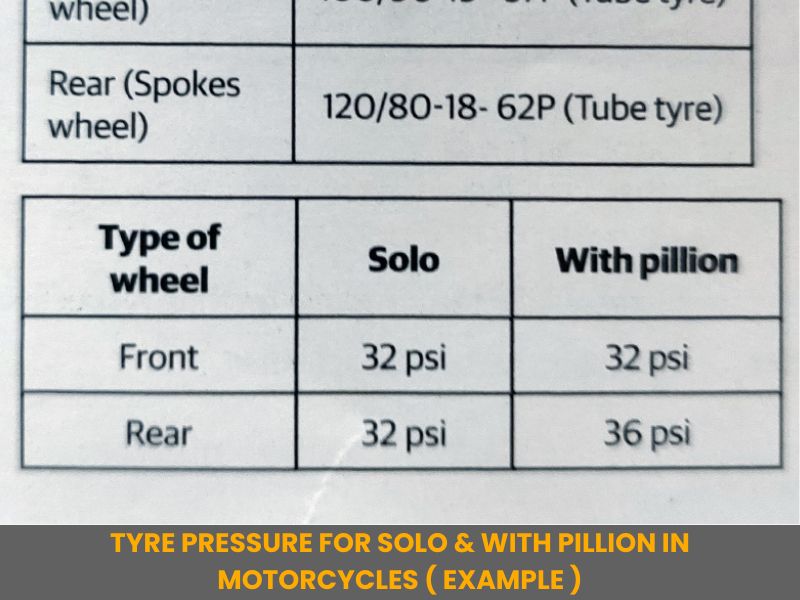
Long story short – Get all your questions about nitrogen versus air filling in bike tyres, tyre pressure, and pressure loss in India answered here. We break down these topics in straightforward language.
Bike owners often have doubts, myths, and misconceptions about the use of nitrogen versus air in tyres, and we aim to clarify these. In tube and tubeless tyres, certain key factors require attention. This article clearly breaks down myths, doubts, and misconceptions.
Key Takeways
- The valve cap is the primary indicator of whether a motorcycle tyre is filled with nitrogen or air. If it’s green, nitrogen is definitely present. If it’s black, it will mostly be air-filled.
- Nitrogen lacks moisture and contaminants, reducing the risk of corrosion compared to air, which contains water vapour.
- Nitrogen filling stations are less common than air compressors, which can be a limitation during long trips.
- Nitrogen helps maintain stable tyre pressure and temperature, which is beneficial for consistent handling.
- The time gap to check the pressure for air-filled tyres is between 1 and 2 weeks.
- The time gap for checking the pressure of nitrogen-filled tyres is 4-5 weeks.
What is nitrogen filling in a bike?
Nitrogen filling means inflating tyres with nitrogen gas instead of regular air. Regular air contains about 78% nitrogen, 21% oxygen, and 1% other gases. Nitrogen-filled tyres contain approximately 93-95% nitrogen.
What is air filling in a bike?
Air filling refers to inflating bike tyres with regular air, primarily consisting of nitrogen (about 78%), oxygen (about 21%), and trace gases. Proper inflation is vital for tyre performance, safety, and lifespan.
What is the difference between nitrogen vs air filling in bike tyres?
1. Molecular Size and Pressure Retention
Nitrogen molecules are larger than oxygen molecules, so tyre pressure drops more slowly with nitrogen. Nitrogen-filled tyres keep pressure longer than air-filled tyres. This can reduce pressure checks and provide a steadier ride.
2. Temperature Stability and Moisture Content
Nitrogen is inert, so it does not react or corrode the inner surface of bike tyres. It also lacks the moisture and corrosive compounds found in air, reducing tyre oxidation.
Nitrogen-filled bike tyres can run cooler, which may help reduce the risk of overheating and tyre failure. This can provide more consistent handling and grip, offering riders added confidence.
3. Cost and Availability
A key drawback of nitrogen is cost. Nitrogen is usually more expensive than air, though some stations provide it free or at a small charge. Nitrogen filling stations can be challenging to find in remote areas, resulting in increased inconvenience.
4. Performance and Practicality
While nitrogen provides benefits such as improved pressure retention and reduced moisture content, the real-world performance improvements for regular riders are typically minimal. Key takeaway: Understand these differences to make informed and confident decisions about tyre inflation.
Regular air already contains 78% nitrogen, so for most daily riders, the extra cost and inconvenience of pure nitrogen rarely outweigh the practical benefits of regular air. Key takeaway: For everyday use, regular air is sufficient, accessible, and cost-effective.
Comparison of Nitrogen and normal air filling in motorcycles – Table
| Feature | Nitrogen Air | Normal Air |
|---|---|---|
| Composition | 93-95% pure nitrogen, minimal moisture | 78% nitrogen, 21% oxygen, contains moisture |
| Pressure Retention | Slower pressure loss, more stable | Faster pressure loss, frequent top-ups needed |
| Heat Resistance | Maintains tyre temperature better | More prone to temperature changes |
| Tyre Longevity | Longer life due to no moisture, reduced oxidation | Slightly shorter life, risk of internal oxidation and corrosion |
| Puncture/Leak Risk | Lower (less permeation) | Slightly higher (air molecules smaller, leak faster) |
| Maintenance | Less frequent pressure checks | More frequent checks needed |
| Cost per Top-Up | Higher (Rs. 40–50 per tyre, paid service, fewer outlets) | Low or free (available at almost all petrol stations/repair shops) |
| Availability | Limited, mostly at major service centers or big cities | Very widely available everywhere |
| Best Suited For | Performance bikes, touring, long interval maintenance, alloy wheels | Routine commuting, city riding, users who check pressure regularly |
| Convenience | Less convenient due to limited filling stations | Very convenient, universally available |
What are the advantages of filling nitrogen in tubeless motorcycle tyres
- Slower bike tyre pressure loss: Nitrogen molecules are larger than oxygen molecules, causing slower pressure loss. This helps maintain consistent pressure for extended periods. It’s beneficial for drivers who rarely check tyre pressure or face changing temperatures.
- Reduced tyre oxidation:Less oxidation occurs with nitrogen inflation because nitrogen lacks moisture. This prevents internal corrosion and may extend a tyre’s lifespan.
- Improved mileage:Consistent pressure with nitrogen inflation can lead to improved mileage. Properly inflated tyres roll more easily, slightly improving fuel economy.
- Enhanced safety:Consistent pressure from nitrogen can improve handling and traction. This adds to overall vehicle safety.
What are the disadvantages of filling nitrogen in tubeless motorcycle tyres?
- Expensive:Nitrogen inflation usually costs more than using regular air in your tyres.
- Availability:Not all gas stations offer nitrogen inflation. If you top up with regular air, the benefits of nitrogen decrease.
- Top-up challenges:Ideally, remove air from the tyre and then refill it with nitrogen.
What are the issues with under inflated motorcycle tyres?
- Decreased Handling and Stability: Soft, underinflated tyres flex more, leading to a vague and unpredictable feel while riding, especially when taking corners. This can significantly heighten the chances of accidents.
- Increased Tyre Wear:Too much flexing causes uneven tread wear, especially on the edges. This shortens tyre lifespan and means more frequent replacements.
- Blowouts:A very underinflated tyre can overheat and blow out. This may cause a sudden loss of pressure and control.
- Higher Fuel Consumption:Underinflated tyres create more rolling resistance. Hence, the engine works harder and fuel efficiency drops.
What are the issues with overinflated motorcycle tyres?
- Reduced Traction: An overly firm tyre has less contact with the road surface, reducing grip and traction, especially during braking and cornering. This can be particularly concerning in wet conditions.
- Harsh Ride:Overly firm tyres have less contact with the road, reducing grip and traction, especially when braking or turning. This is particularly dangerous when roads are wet.
- Centre Tread Wear: An overinflated tyre rides stiffly, transmitting more bumps and vibrations. This makes for an uncomfortable journey.
What are the long-term effects of regularly using nitrogen in bike tyres compared to air in India?
Here are the long-term effects of regularly using nitrogen in bike tyres compared to air in India:
- Nitrogen maintains tyre pressure longer due to its larger and less permeable molecules, resulting in fewer top-ups and more consistent performance over time.
- Nitrogen’s stable pressure can reduce uneven tyre wear. This often extends tyre life if used consistently.
- Being inert and dry, nitrogen eliminates the risk of internal oxidation and rim corrosion, a crucial factor in India’s humid and monsoon-prone climate.
- Nitrogen-filled tyres lose heat faster, staying cooler on long rides. This lowers the risk of overheating or blowouts on Indian roads.
- Tyres with nitrogen are less prone to sudden punctures and blowouts due to stable pressure, enhancing long-term safety.
- The main disadvantages are higher filling costs and limited availability at service stations in most Indian cities and rural areas.
- Regular air is free and widely available for most daily riders. It is practical for frequent top-ups, though pressure may fluctuate more than with nitrogen.
- For budget-focused and city riders who often check tyre pressure, the long-term difference is minimal. Key takeaway: Nitrogen shows clearer benefits for high-performance tyres or when maintenance is infrequent.
FAQ related to nitrogen vs air filling in bike tyres
1. Is there a benefit to adding nitrogen to tube tyres in motorcycles?
No. Nitrogen is placed inside the tube, so it does not protect the outer tyre from heat or vibration. Tube tyres do not benefit from nitrogen, so air is better for them.
2. Does regular air or compressed air contain nitrogen?
Yes. Regular air is about 78% nitrogen, 21% oxygen, and 1% other gases. Compressed air is normal air forced into a smaller space, increasing pressure.
3. What is the time gap for air pressure checking in motorcycles?
The time gap to check the pressure for air-filled tyres is between 1 and 2 weeks.
4. What is the time gap for nitrogen pressure checking in motorcycles?
The time gap for checking the pressure of nitrogen-filled tyres is 4-5 weeks.
5. Do petrol pumps in India offer nitrogen filling in motorcycles?
No, in India, petrol pumps primarily offer compressed air for tyre filling, not nitrogen.
6. How do you know if a motorcycle tyre is filled with nitrogen or air?
The valve cap is the primary indicator of whether a motorcycle tyre is filled with nitrogen or air. If it’s green, nitrogen is definitely present. If it’s black, it will mostly be air-filled.
7. How to check for motorcycle tyre pressure at home?
There are devices specifically for analogue and digital devices to check tyre pressure at home.
Check out this link for more details.
8. What is the recommended tyre pressure for both front and rear tyres in motorcycles?
Check the owner’s manual for specific details on the exact tyre pressure for the front and rear tyres.
9. Should we increase the tyre pressure if there is a pillion passenger on both motorcycle tyres?
It is usually provided in the owner’s manual, as shown in the picture below. Tyre pressure should be higher on the rear wheel, while on the front wheel, it’s almost the same, especially if a pillion is present. Check the picture given below.
10. Which is more expensive, nitrogen or air filling in motorcycles?
Nitrogen is definitely the most expensive fuel. Air filling is entirely free at petrol pumps, while in other shops, it costs around Rs 10-20 per bike tyre (approximately); nitrogen filling costs between Rs 30-40 per tyre (approximately).
11. Does nitrogen fill significantly improve fuel efficiency?
Nitrogen inflation usually improves fuel efficiency minimally compared to the benefits of maintaining proper bike tyre pressure with regular air.
12. Why is compressed air considered harmful to tyres?
Compressed air contains oxygen, which can cause oxidation and destroy rubber and other tyre materials, leading to deterioration over time.
13. Can I mix air with nitrogen in my tyres?
While it’s possible to add air to nitrogen-filled tyres, it reduces the nitrogen concentration. It’s better to maintain correct inflation with air than to have under-inflated tyres with nitrogen.
14. Does nitrogen improve fuel economy and tyre life?
Properly inflated tyres, whether with nitrogen or air, can improve fuel economy and extend tyre life. Nitrogen may offer slight advantages in maintaining consistent pressure.
15. Are nitrogen filling stations widely available?
Nitrogen filling stations are less common than air compressors, which can be a limitation during long trips.
16. Does nitrogen prevent tyre corrosion?
Nitrogen lacks moisture and contaminants, reducing the risk of corrosion compared to air, which contains water vapour.
17. Is nitrogen suitable for all types of tyres?
Nitrogen is ideal for all tyres and vehicles, providing benefits like consistent pressure and reduced moisture.
18. Does nitrogen affect tyre temperature stability?
Nitrogen helps maintain stable tyre pressure and temperature, which is beneficial for consistent handling.
19. What is the nitrogen purity level in tyres?
When nitrogen is filled into tyres, the concentration typically reaches 93% – 95%.
Common myths about nitrogen vs air filling in bike tyres
Myth 1: Nitrogen does not leak from tyres as quickly as air.
Fact: Both nitrogen and air will leak over time, but nitrogen leaks at a slower rate due to larger molecules.
Myth 2: Nitrogen is unaffected by temperature changes.
Fact: Nitrogen-filled tyres maintain pressure better in fluctuating temperatures but are not immune to temperature-related changes.
Myth 3: Nitrogen-filled tyres are maintenance-free.
Fact: Regular pressure checks are necessary for nitrogen-filled tyres to identify leaks and ensure safety.
Myth 4: Nitrogen completely prevents tyre and wheel corrosion.
Fact: While nitrogen reduces moisture, most air systems already limit water vapour, making corrosion from air not a widespread issue.
Myth 5: Nitrogen significantly improves ride quality.
Fact: Little evidence supports claims of improved ride quality with nitrogen.
Myth 6: Nitrogen saves significant fuel costs.
Fact: The fuel savings from using nitrogen are minimal and often not noticeable.
Myth 7: Nitrogen is a new technology.
Fact: Nitrogen has been used in various applications, including aviation and racing, for many years.
Myth 8: Nitrogen is non-reactive and completely safe.
Fact: Nitrogen is inert and stable, making it safe for tyre use.
Myth 9: Nitrogen is not worth the cost for average riders.
Fact: For most riders, the benefits of nitrogen do not outweigh the price, especially when air is free and readily available.
Other related articles from Bikeleague India
- Best bike tyre brands for your motorcycle in India
- Types of Two wheeler tyres explained
- How to read two wheeler tyre code and tyre size
- What is Motorcycle ABS? – Doubts, Queries and FAQ
- Top 10 proven tips to increase two wheeler mileage/
Conclusion
We hope that all doubts, myths, and misconceptions about nitrogen and air filling in motorcycles are clear. If you have any other questions or queries, email us at bikeleague2017@gmail.com.
You can also share your doubts or opinions in the comments section below. We are always eager to help and assist you. Additionally, there are several social media platforms associated with Bikeleague India that may raise your suspicions.



